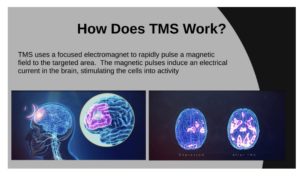Transcranial Magnetic Stimulation (TMS)
This is a procedure that’s non-invasive which utilizes magnetic fields to provide stimulation to nerve cells within the brain to improve depression symptoms. TMS is naturally utilized when other treatments for depression have not been effective.
How Does TMS work?
Throughout the session of TMS, an electromagnetic coil is laid on your scalp close to your forehead. The electromagnet delivers painlessly a magnetic pulse that provides stimulation to the nerve cells in the region of your brain involved in both depression and mood control. It is thought to trigger regions of the brain that have decreased activity in depression.
Treatment Resistant Depression
Approximately 50% to 60% of people with depression who have tried and failed to receive benefits from medications experience a clinically significant response with TMS. Amongst these individuals, about one-third experience a full remission, which means that their symptoms completely go away.
A Typical TMS Session
– Patient removes jewelry, wears ear plugs, and sits in a comfortable chair
– A TMS cap is fitted on the patient’s head
– TMS Magnet is placed on the head which makes clicking sound and the patient might feel gentle repetitive taps on the scalp
– First session is typically an hour. Subsequent sessions last 20-30 minutes
After the session is over, patients can return to their usual activities
Side Effects
Common Side Effects
Side effects are usually minor to moderate and shortly improve after an individual session and decrease over time with additional sessions. They may include lightheadedness, twitching or spasms of facial muscles, tingling, scalp discomfort at the site of stimulation, and headache.
Your doctor can adjust the level of stimulation to reduce symptoms or may recommend that you take an over-the-counter pain medication before the procedure.
Uncommon Side Effects
Serious side effects are rare. They may include Seizures, Mania, mainly in those with bipolar disorder, loss of hearing if there is insufficient ear protection throughout treatment.



